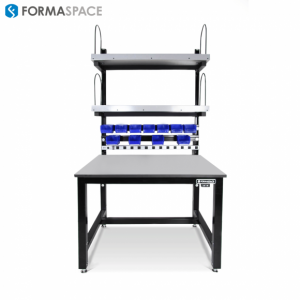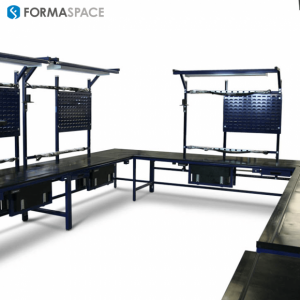How to Make an Assembly Line More Efficient in 2021

Formaspace offers a full line of transparent dividers to help companies comply with CDC guidance for protecting workers on the job. We can also manufacture custom units to meet your unique requirements.
Here are the 10 most important areas to focus on when it comes to investing in the efficiency of your assembly operations.
The changing of the calendar marks a new start, a fresh beginning.
How can American manufacturing companies make the best of it?
The challenges facing the industry are great. US trade deficits reached an all-time high in 2020, as the Coronavirus put the economy on the back foot. And, as the American economy contracted during 2020, it’s continued to fall further behind China, which Bloomberg now estimates will take over the mantle as the world’s largest economy as soon as the year 2028.
How can we change course? According to Elon Musk, who recently overtook Amazon’s Jeff Bezos as the world’s wealthiest individual, the answer lies in increasing our investment in innovation.
Heeding Musk’s advice, we take a look at 10 areas that manufacturing companies should invest their time and resources in to achieve greater productivity and maximum return on investment.
1) Invest In People
An Educated, Innovative, And Healthy Workforce Is Your Number One Asset
It takes a capable, innovative workforce to be successful in the competitive manufacturing market, which means people are the most important investment of all. The Coronavirus pandemic has only heightened the need to improve safe working conditions, but there are other important considerations to help you attract the best and brightest employees:
Follow Covid Safety Guidelines
Use CDC’s Covid 19 safety guidance to create a plan to protect your workers from transmitting the virus; this will include improved ventilation, increased social distancing, and adding transparent shields between workers who must work close to each other.
Step-Up Accident Prevention Programs
Slips, trips, and falls (STF) and overexertion (caused by lifting heavy items incorrectly or working longer hours overhead) are among the most common causes of Musculoskeletal Disorders (MSDs). See our article How to Prevent Injuries at a Manufacturing Facility for advice on how to change work practices to avoid on-the-job injuries.
Invest in Good Ergonomics and Employee Wellness
Improper seating positions and long hours on the job can also lead to increased fatigue and injuries. Consider investing in proper ergonomic seating and workbench layouts, including work surfaces that can be raised or lowered to fit individual employees properly.
Equal Opportunity Employee Training and Mentoring Opportunities
As older baby boomer workers retire, do you have a plan for recruiting the next generation of workers? Consider investing in local school stem programs and sponsoring internships that introduce the benefits of a manufacturing career to student populations who may not have considered how rewarding a career in manufacturing can be.
Create an Attractive Work Environment
Many of today’s high-tech manufacturing assembly facilities bear little resemblance to the dirty smokestack operations of the past. Creating a clean, organized, and attractive workspace is an important recruiting tool for attracting new talent.
2) Invest In New Product Technology
Leverage New Materials, Technologies, And Product Designs To Reduce Part Count And Improve Assembly Line Efficiency
Design for Manufacturing (DFM) has been a long-standing principle used by manufacturing engineers to improve the productivity of assembly lines – either reducing the number of parts required or simplifying their assembly or both. But recent technology innovations have supercharged DFM thanks to new design tools and product technology:
AR/VR and AI-based CAD Tools / Manufacturing Simulation Software
Advanced augmented reality and virtual reality tools are now joined with AI-based engineering optimization tools that can help product engineers optimize product designs across multiple disciplines. (The Tesla car’s “Superbottle” that provides cooling to the electric motor and battery as well as the passenger compartment is a famous example of multidisciplinary design optimization.) Similar advances in manufacturing simulation software help industrial engineers optimize assembly workflows even before new assembly construction begins. These same technologies can also be used to train factory workers to learn new assembly line techniques.
Integrating Microprocessors, Sensors, and Software into Product Designs
Thanks to increased microprocessor power and miniaturization of sensors, many product designs are now smaller and simpler, with fewer mechanical parts compared to previous generations, which can speed up product assembly once a manufacturing line is converted to handling electronic components assembly. Companies such as Apple are taking this further by designing and manufacturing their own microprocessor chips.
Electrification Replaces ICE Motors, Conventional Hydraulic, and Pneumatic Systems
Electric vehicles (EVs) have far fewer parts compared to conventional internal combustion engine (ICE) models, eliminating about one-third of the components needed for assembly. Advances in electric motors and control systems may cut demand for hydraulic and pneumatic systems as well: the Boeing 787 Dreamliner has replaced conventional hydraulic-powered flight control system and pneumatic-powered pressurization and air-conditioning packs with an all-electric system, which utilizes fewer individual components and is easier to upgrade.
3) Invest In Flexible, Customized Manufacturing
Satisfy Customer Demand For Unique, Custom Products
The Coronavirus pandemic has underscored the need for manufacturers to make their factory operations more flexible to respond to sudden changes in consumer demand.
For example, many companies producing paper goods destined for the restaurant, hospitality, and entertainment markets found it difficult to repackage products in high demand, such as toilet paper, for sale to consumers spending more time at home.
The pandemic also seems to have increased consumer appetite for online shopping, which creates new opportunities for manufacturing companies:
Offer Products Directly to Consumers
Manufacturers can take advantage of direct customer sales opportunities over the Internet if they invest in the necessary infrastructure, including efficient packing and shipping operations.
Offer Customized or Limited Run Products
Prospective customers are increasingly looking for unique, exclusive products. Savvy manufacturers are responding by offering short or one-off production runs.
Read more...
Julia Solodovnikova
Formaspace
+1 800-251-1505
email us here
Visit us on social media:
Facebook
Twitter
LinkedIn
Legal Disclaimer:
EIN Presswire provides this news content "as is" without warranty of any kind. We do not accept any responsibility or liability for the accuracy, content, images, videos, licenses, completeness, legality, or reliability of the information contained in this article. If you have any complaints or copyright issues related to this article, kindly contact the author above.


